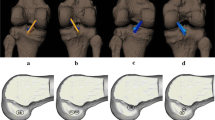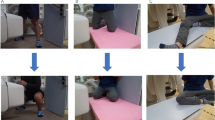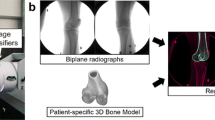Abstract
Purpose
Rehabilitation is an important aspect of both non-operative and operative treatments of knee ligament tear. Posterior cruciate ligament (PCL) non-operative treatment consists of a step-by-step rehabilitation protocol and is well described. It goes from rest (phase I) to strengthening exercises (phase IV). More specific and high-intensity exercises such as cutting, sidestepping or jumps are, however, not described in detail, as no in vivo data exist to tell how these exercises constrain the ligaments and whether they have the same effect on all of them, in particular regarding lengthening. The goal of this study was to measure the ligament lengthening in static knee flexion based on 3D reconstructions from magnetic resonance imaging (MRI) and from motion capture and ligament simulation during dynamic exercises.
Methods
The knee of nine volunteers was first imaged in a closed-bore MRI scanner at various static knee flexion angles (up to 110°), and the corresponding lengthening of the PCL and the other major knee ligaments was measured. Then, the volunteers underwent motion capture of the knee where dynamic exercises (sitting, jumping, sidestepping, etc.) were recorded. For each exercise, knee ligament elongation was simulated and evaluated.
Results
According to the MRI scans, maximal lengthening occurred at 110° of flexion in the anterior cruciate ligament and 90° of flexion in the PCL. Daily living movements such as sitting were predicted to elongate the cruciate ligaments, whereas they shortened the collateral ligaments. More active movements such as jumping put the most constrain to cruciate ligaments.
Conclusion
This study provides interesting insights into a tailored postoperative regimen. In particular, knowing the knee ligament lengthening during dynamic exercises can help better define the last stages of the rehabilitation protocol, and hence provide a safe return to play.





Similar content being viewed by others
References
Agolley D, Gabr A, Benjamin-Laing H, Haddad F (2017) Successful return to sports in athletes following non-operative management of acute isolated posterior cruciate ligament injuries: medium-term follow-up. Bone Joint J 99-B(6):774–778
Ali A, Harris M, Shalhoub S, Maletsky L, Rullkoetter P, Shelburne K (2016) Combined measurement and modeling of specimen-specific knee mechanics for healthy and ACL-deficient conditions. J Biomech 24(57):117–124
Amis A, Bull A, Gupte C, Hijazi I, Race A, Robinson J (2003) Biomechanics of the PCL and related structures: posterolateral, posteromedial and meniscofemoral ligaments. Knee Surg Sport Traumatol Arthrosc 11(5):271–281
Chandrasekaran S, Ma D, Scarvell J, Woods K, Smith P (2012) A review of the anatomical, biomechanical and kinematic findings of posterior cruciate ligament injury with respect to non-operative management. Knee 19(6):738–745
Charbonnier C, Chagué S, Kolo F, Duthon V, Menetrey J (2017) Multi-body optimization with subject-specific knee models: performance at high knee flexion angles. Comput Meth Biomech Biomed Eng 20(14):1571–1579
Charbonnier C, Lädermann A, Kevelham B, Chagué S, Hoffmeyer P, Holzer N (2018) Shoulder strengthening exercises adapted to specific shoulder pathologies can be selected using new simulation techniques: a pilot study. Int J CARS 13(2):321–330
Clément J, Dumas R, Hagemeister N, de Guise J (2015) Soft tissue artifact compensation in knee kinematics by multi-body optimization: performance of subject-specific knee joint models. J Biomech 48:3796–3802
Clément J, Dumas R, Hagemeister N, de Guise J (2017) Can generic knee joint models improve the measurement of osteoarthritic knee kinematics during squatting activity? Comput Meth Biomech Biomed Eng 20(1):94–103
de Paula Leite Cury R, Dan Kiyomoto H, Fogolin Rosal G, Fernandes Bryk F, Marques de Oliveira V, Arbix de Camargo O (2012) Rehabilitation protocol after isolated posterior cruciate ligament reconstruction. Rev Bras Orthop 47(4):421–427
Dragoo J, Phillips C, Schmidt J, Scanlan S, Blazek K, Steadman J, Williams A (2010) Mechanics of the anterior interval of the knee using open dynamic MRI. Clin Biomech 25:433–437
Duprey S, Chèze L, Dumas R (2010) Influence of joint constraints on lower limb kinematics estimation from skin markers using global optimization. J Biomech 43(14):2858–2862
Englander ZA, Baldwin E, Smith W, Garrett W, Spritzer C, DeFrate L (2019) In vivo anterior cruciate ligament deformation during a single-legged jump measured by magnetic resonance imaging and high-speed biplanar radiography. Am J Sport Med 47(13):3166–3172
Gasparutto X, Sancisi N, Jacquelin E, Parenti-Castelli V, Dumas R (2015) Validation of a multi-body optimization with knee kinematic models including ligament constraints. J Biomech 48:1141–1446
Goyal K, Tashman S, Wang J, Li K, Zhang X, Harner C (2012) In vivo analysis of the isolated posterior cruciate ligament-deficient knee during functional activities. Am J Sports Med 40(4):777–785
Kim H, Seo H, Kim H, Nguyenn T, Shetty N, Yoo Y (2011) Tension changes within the bundles of anatomic double-bundle anterior cruciate ligament reconstruction at different knee flexion angles: a study using a 3-dimensional finite element model. Arthroscopy 27(10):1400–1408
Kim J, Lee Y, Yang B, Oh S, Yang S (2013) Rehabilitation after posterior cruciate ligament reconstruction: a review of the literature and theoretical support. Arch Orthop Trauma Surg 133(12):1687–1695
King AJ, Deng Q, Tyson R, Sharp JC, Matwiy J, Tomanek B, Dunn JF (2014) In vivo open-bore MRI reveals region- and sub-arc-specific lengthening of the unloaded human posterior cruciate ligament. PLoS ONE 7(11):e48714
Komatsu T, Kadoya Y, Nakagawa S, Yoshida G, Takaoka K (2005) Movement of the posterior cruciate ligament during knee flexion—MRI analysis. J Orthop Res 23:334–339
Laprade C, Civitarese D, Rasmussen M, Laprade R (2015) Emerging updates on the posterior cruciate ligament a review of the current literature. Am J Sport Med 43(12):3077–3092
Leardini A, Belvedere C, Nardini F, Sancisi N, Conconi M, Parenti-Castelli V (2017) Kinematic models of lower limb joints for musculo-skeletal modelling and optimization in gait analysis. J Biomech 6(62):77–86
Mueller M, Heidelberger B, Hennix M, Ratcliff J (2007) Position based dynamics. J Vis Comun Image Represent 18(2):109–118
Nakagawa S, Johal P, Pinskerova V, Komatsu T, Sosna A, Williams A, Freeman M (2004) The posterior cruciate ligament during flexion of the normal knee. J Bone Joint Surg Br 86:450–456
Provot X (1997) Collision and self-collision handling in cloth model dedicated to design garment. In: Computer animation and simulation’97. Springer, Vienna, pp 177–189
Ramaniraka N, Terrier A, Theumann N, Siegrist O (2005) Effects of the posterior cruciate ligament reconstruction on the biomechanics of the knee joint: a finite element analysis. Clin Biomech 20:434–442
Richard V, Lamberto G, Lu T, Cappozzo A, Dumas R (2016) Knee kinematics estimation using multi-body optimisation embedding a knee joint stiffness matrix: a feasibility study. PLoS ONE 11(6):e0157010
Richard V, Cappozzo A, Dumas R (2017) Comparative assessment of knee joint models used in multi-body kinematics optimisation for soft tissue artefact compensation. J Biomech 6(62):1–7
Sangeux M, Marin F, Charleux F, Duerselen L, Tho MCHB (2006) Quantification of the 3D relative movement of external marker sets vs. bones based on magnetic resonance imaging. Clin Biomech 21:984–991
Scarvell J, Smith P, Refshauge K, Galloway H, Woods K (2004) Evaluation of a method to map tibiofemoral contact points in the normal knee using MRI. J Orthop Res 22:788–793
Song Y, Debski R, Musahl V, Thomas M, Woo S (2004) A three-dimensional finite element model of the human anterior cruciate ligament: a computational analysis with experimental validation. J Biomech 37(3):383–390
Taylor K, Terry M, Utturkar G, Spritzer C, Queen R, Irribarra L, Garrett W, DeFrate L (2011) Measurement of in vivo anterior cruciate ligament strain during dynamic jump landing. J Biomech 44(3):365–371
Utturkar G, Irribarra L, Taylor K, Spritzer C, Taylor D, Garrett W, Defrate LE (2013) The effects of a valgus collapse knee position on in vivo ACL elongation. Ann Biomed Eng 41(1):123–130
Vairis A, Stefanoudakis G, Petousis M, Vidakis N, Tsainis A, Kandyla B (2016) Evaluation of an intact, an ACL-deficient, and a reconstructed human knee joint finite element model. Comput Meth Biomech Biomed Eng 19(3):263–270
van den Bergen G (1997) Efficient collision detection of complex deformable models using AABB trees. J Graph Tools 2(4):1–14
Wu G, Siegler S, Allard P, Kirtley C, Leardini A, Rosenbaum D, Whittle M, Lima D, Cristofolini L, Witte H, Schmid O, Strokes I (2002) ISB recommendation on definitions of joint coordinate system of various joints for the reporting of human joint motion—part I: ankle, hip and spine. J Biomech 35(4):543–548
Yao J, Lancianese S, Hovinga K, Lee J, Lerner A (2008) Magnetic resonance image analysis of meniscal translation and tibio-menisco-femoral contact in deep knee flexion. J Orthop Res 26:673–684
Author information
Authors and Affiliations
Corresponding author
Ethics declarations
Conflict of interest
The authors declare that they have no conflict of interest.
Ethical standard
Institutional ethical approval (CCER n°15-043) was obtained prior to data collection. All procedures performed in the study were in accordance with the ethical standards of the institutional and/or national research committee and with the 1964 Helsinki Declaration and its later amendments or comparable ethical standards.
Informed consent
Informed consent was obtained from the individual participant included in the study.
Additional information
Publisher's Note
Springer Nature remains neutral with regard to jurisdictional claims in published maps and institutional affiliations.
Electronic supplementary material
Below is the link to the electronic supplementary material.
Supplementary material 1 (MP4 43902 kb)
Rights and permissions
About this article
Cite this article
Charbonnier, C., Duthon, V.B., Chagué, S. et al. In vivo static and dynamic lengthening measurements of the posterior cruciate ligament at high knee flexion angles. Int J CARS 15, 555–564 (2020). https://doi.org/10.1007/s11548-019-02107-9
Received:
Accepted:
Published:
Issue Date:
DOI: https://doi.org/10.1007/s11548-019-02107-9




